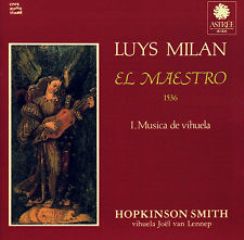Luys Milan - El Maestro, Vol. 1 Musica de Vihuelo (Hopkinson Smith) [1994]
Luys Milan - El Maestro, Vol. 1 Musica de Vihuelo (Hopkinson Smith) [1994]

Tonos 1 & 2 01. Fantasia XIII 1:49 02. Pavana I 1:13 03. Tento I 7:34 04. Fantasia XI 3:12 05. Fantasia X 2:11 Tonos 3 & 4 06. Fantasia XII 2:30 07. Fantasia VIII 2:05 08. Tento II 5:32 Tonos 5 & 6 09. Fantasia XVI 2:47 10. Pavana III 2:00 11. Fantasia XV 3:31 Tonos 7 & 8 12. Fantasia XVIII 3:09 13. Pavana IV 1:49 14. Pavana V 1:16 15. Fantasia XXII 2:46 16. Tento IV 5:51 Hopkinson Smith - vihuela
I love this disc, I am a classical guitarist, and a huge fan of the vihuela repertoire. I was looking for a recording of Milan's music and much to my delight found that Hopkinson Smith had recorded it. It gave me a lot of insight into the way in which this music should be performed, and is very faithful to the text and period performance practices. Hopkinson Smith is awesome as usual, and now I've been inspired to pick up the vihuela da mano! --- Perry Brooks Nichols, amazon.com
Luis de Milán, a Spanish composer and poet, is important as a composer of music for the vihuela; as well as writing solo works for the instrument, he employed it in an accompanimental role in songs. Little is known of Luis de Milán's life. He spent most of his adulthood in the Spanish coastal city of Valencia, engaged at the ducal court; his connections with the court seem to have dissolved around 1538, not long after he began publishing his works. Milán enjoyed royal patronage after retiring from the Valencia court, however, and his El cortesano, printed in 1561, is dedicated to Philip II of Spain.
Milán published a significant amount of music; one of the earliest of these publications is a parlor-game book entitled, El juego de mandar, printed in 1535 in Valencia. His most important volume by far is his Libro de música de vihuela de mano intitulado El maestro (Valencia, 1536); containing instrumental and vocal pieces in succession, it provides valuable insight into the nature of improvisational playing that lutenists of the time may have used as preludes to songs. A good example is "Fantasia No. 9," which prepares for the ensuing vocal piece by moving, several times, to a cadence in both of the modes of the song; this sets the modes of the song in listeners' ears before it even begins.
The 40 fantasias in El maestro are free in structure and contain both homophonic and polyphonic passages. Typically for his time, Milán attached no specific meaning to the term "fantasia" and applied it to seemingly any instrumental piece for solo vihuela. The fantasias are clearly sectionalized, and their polyphonic segments are usually free rather than imitative. Milán's facility on the vihuela is evident in the virtuoso runs and ornaments that appear throughout the fantasias.
Milan transposed the various modal scales to different starting pitches, requiring an unusual use of accidentals for the time. More interesting still is his combination of modes in a single piece, such as "Fantasia No. 14." Also, "Fantasia No. 27" features striking chromatic writing, with augmented unisons and triads; among the songs, both "Durandarte" and the soneto Nova angeleta (text by Petrarch), contain bold cross-relations -- the simultaneous sounding of two versions of the same note (E natural and E flat, for example).
The vocal works contained in El maestro include 12 villancicos (six in Castillian and six in Portuguese), four romances and six sonetos. Of the 12 villancicos, ten are "double versions"; five of these are relatively simple in texture, though the singer is directed to ornament the voice part. In each of the second versions of these, however, the vihuela part is much more elaborate and the voice part is to be sung as written; Milán clearly conceived of the vihuela as an equal "voice" in these works.
Interestingly, Milán was among the first documented users of the term sonada, although he did not do so to indicate a type of composition; in his usage, it connoted the "sound" or "style" of the piece -- the fifth and sixth pavans in El maestro, for example, have an Italian "sonada." ---John Palmer, Rovi
Luis Milán (Valencia, c. 1500- id., c. 1561) Vihuelista español. Es autor del Libro de música de vihuela de mano intitulado Él maestro» (1536), primer tratado conocido de vihuela y uno de los primeros documentos de música con indicaciones de tiempo; está formado por fantasías, tientos, pavanas, villancicos, romances y sonetos. ---biografiasyvidas.com
download (mp3 @320 kbs):
uploaded yandex 4shared mediafire mega solidfiles zalivalka cloudmailru filecloudio oboom








